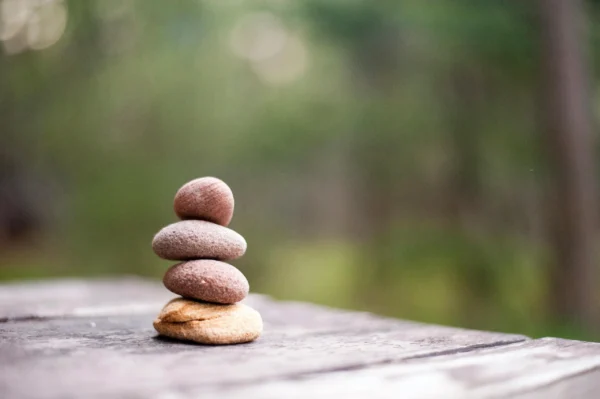“Grounding Emotionally” is the first in a monthly column of mental health articles by Karen Munson. Read the next article, “Important Words,” at the link.
In previous Byway Issues, the newspaper published a few ways we can help ourselves emotionally, mentally and physically. The first three articles addressed having a morning routine, practicing earthing or grounding physically, and administering tapping to pressure points. This article will detail methods for grounding emotionally.
Jennie Lannette, a licensed clinical social worker and practicing therapist in Missouri, shared in a blog post two related ways to ground yourself emotionally: awareness of senses, and grounding rocks. We add one more method, which we will discuss later.
The theory behind Lannette’s grounding is essentially a form of mindfulness, which helps people practice awareness of the present moment. Mindfulness is a well-researched method often used alongside cognitive behavioral therapy, dialectical behavioral therapy and others, but it can be done on your own, too.
A number of studies have shown that humans’ emotional processing and response is controlled in the amygdala part of the brain. Grounding, meditation, mindfulness, whatever you want to call it, helps people become aware of and improve their amygdala response. Thus, they can be more logical and practical in making decisions both in an emotional moment and in the future. According to a study done in Denmark, mindfulness makes it easier to get over fears as well.
The following techniques outlined by Lannette and these studies help us focus on the present.
Using Your Senses
Using your senses can help you become conscious of where you are right now so your mind is not in the past or future.
Feel your feet on the floor. Feel the support of whatever is beneath you. Feel the contact that your skin makes with whatever it is touching. Feel the movement of air around you. Once you are fully present, do the following:
- List three things you can hear: the TV, a fan, music, people talking, traffic …
- List three things you can see: a picture, your shoes, a plant, a view outside the window, a light …
- List three things you can touch: a stuffed animal, your clothing, a blanket, the chair you are sitting on, a plant …
- List three things you can smell: coffee, lotion, perfume, food cooking, a burning candle …
- List three things you can taste: gum, a mint, a soda, your favorite food …
Now, breathe in through your nose, hold, and breathe out slowly through your mouth three times.
Grounding Rocks
Grounding rocks can also be effective in calming the amygdala. Lannette liked to use grounding rocks with her patients who initially struggled with using their senses. Using rocks can be a great introduction into mindfulness, she said.
Select a rock, even one from your driveway, or while out on a walk. Choose one that resonates with you. It can be small, like a quarter, or larger, like a pancake. Use your senses to interact with the stone. What does it feel and look like? What are its unique characteristics? Weight? Texture? Colors?
As you hold the rock, fully conscious of its qualities, it enhances mindfulness, keeping you present physically and mentally, increasing the calming effect.
You may paint or decorate your rock. Own it. Embrace it. Carry it around in your pocket or purse as a readily available stimulus for calm. It offers a tangible ‘something’ to hold on to and focus on while developing mindfulness, or the ability to stay present. Let go of the past, and trust that the future will unfold as it should.
Epsom Salt Baths
Epsom salt baths promote relaxation from feeling stressed and being overwhelmed, according to a medically reviewed article from Healthline.
Magnesium deficiency is known to be related to increased anxiety. Healthy magnesium levels can reduce physical and mental stress and promote sleep by increasing brain neurotransmitters and melatonin, a sleep hormone. The article posited that the magnesium in Epsom salt could help increase the amount in your body by magnesium absorption through the skin. The Byway could not confirm this by use of further studies.
In addition, the heat and relaxation of the water can also reduce stress.
How to make an Epsom salt bath:
- Pour 2 cups of Epsom salts under the running faucet of a standard-size tub. After the salts dissolve, the water should feel soapy.
- Soak for 12 to 20 minutes.
- Adding essential oils such as lavender, peppermint, or tea tree can increase relaxation.
Life is stressful for everyone. By implementing these three simple techniques when our stress levels become uncomfortable, we can reduce more stress, think more logically and become kinder humans.
– by Karen Munson

Karen M. Munson – Escalante
Karen is an associate editor at The Byway. She is fascinated and fulfilled by all things involved with writing. After graduating from BYU, she taught English at Escalante High School for three years. She pursues opportunities to write and support others in their writing. Karen has published three books with four more scheduled to be released in 2024. She and Reed are the parents of ten children and the grandparents of 35 grandchildren.
Karen is the author of the New Twist on Mental Health column in The Byway.

